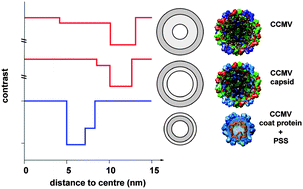Solution scattering studies on a virus capsid protein as a building block for nanoscale assemblies†
Abstract
Self-assembled

Maintenance work is planned for Wednesday 1st May 2024 from 9:00am to 11:00am (BST).
During this time, the performance of our website may be affected - searches may run slowly and some pages may be temporarily unavailable. If this happens, please try refreshing your web browser or try waiting two to three minutes before trying again.
We apologise for any inconvenience this might cause and thank you for your patience.
* Corresponding authors
a
Department of Organic Chemistry, Institute for Molecules and Materials, Faculty of Science, Radboud University Nijmegen, Heyendaalseweg 135, Nijmegen, AJ, The Netherlands
E-mail:
m.feiters@science.ru.nl
Fax: +.31.24.3652929
Tel: +.31.24.3652016/2676
b Large Scale Structures Group, ISIS Pulsed Neutron & Muon Source, Science & Technology Facilities Council, Rutherford Appleton Laboratory, Harwell Science and Innovation Campus, Didcot, United Kingdom
c NWO Physics, present address: Reactor Institute Delft, Department RRR, Section FAME, Delft University of Technology, Mekelweg 15, Delft, The Netherlands
d Present address: Laboratory for Biomolecular Nanotechnology, University of Twente, Enschede, The Netherlands
Self-assembled

 Please wait while we load your content...
Something went wrong. Try again?
Please wait while we load your content...
Something went wrong. Try again?
M. Comellas-Aragonès, F. D. Sikkema, G. Delaittre, A. E. Terry, S. M. King, D. Visser, R. K. Heenan, R. J. M. Nolte, J. J. L. M. Cornelissen and M. C. Feiters, Soft Matter, 2011, 7, 11380 DOI: 10.1039/C1SM06123B
To request permission to reproduce material from this article, please go to the Copyright Clearance Center request page.
If you are an author contributing to an RSC publication, you do not need to request permission provided correct acknowledgement is given.
If you are the author of this article, you do not need to request permission to reproduce figures and diagrams provided correct acknowledgement is given. If you want to reproduce the whole article in a third-party publication (excluding your thesis/dissertation for which permission is not required) please go to the Copyright Clearance Center request page.
Read more about how to correctly acknowledge RSC content.
 Fetching data from CrossRef.
Fetching data from CrossRef.
This may take some time to load.
Loading related content
